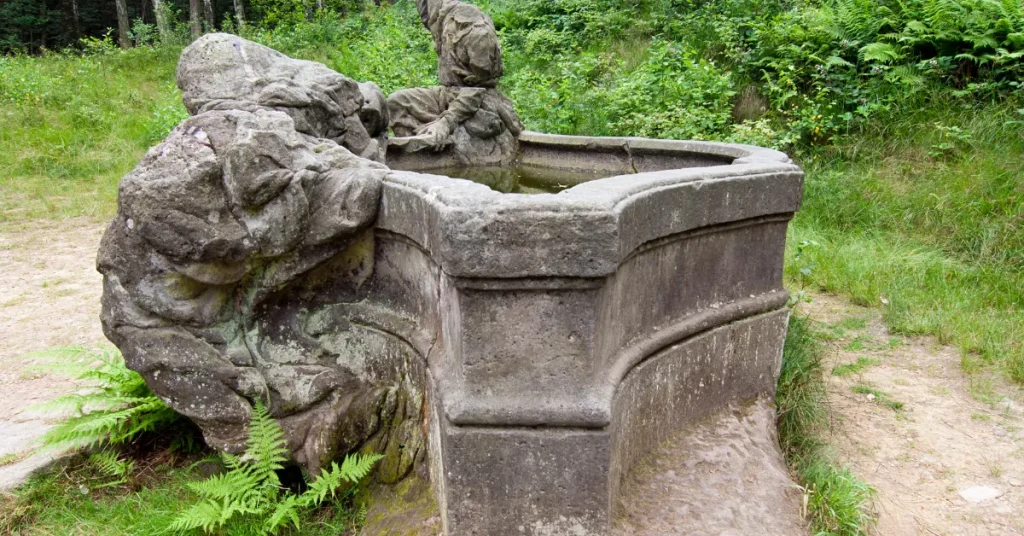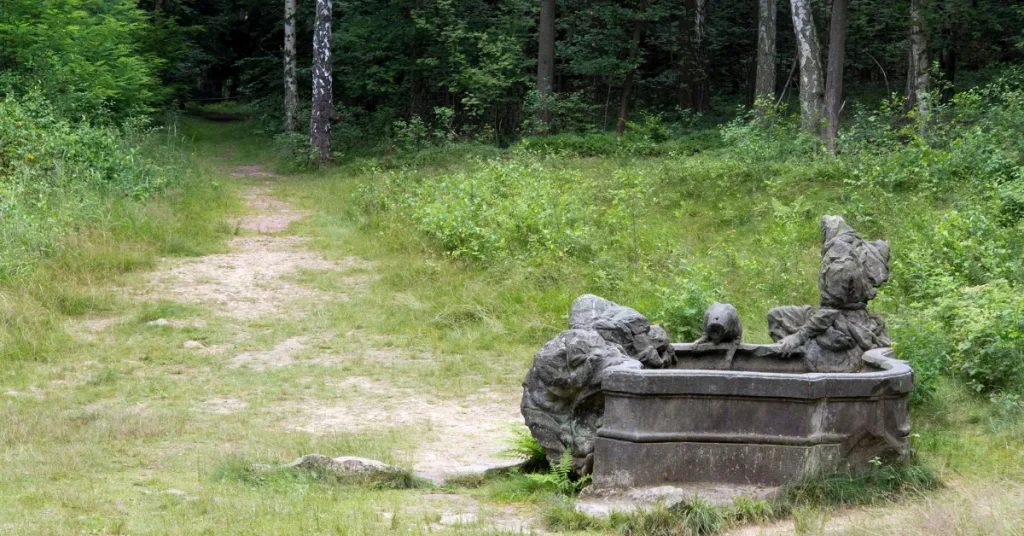Jacob’s Well has a depth of approximately 100 feet to the bottom chamber. Its deepest point reaches about 140 feet.
Nestled in the Texas Hill Country, Jacob’s Well is a perennial karstic spring that flows from the bed of Cypress Creek, located in Wimberley, Texas.
This natural wonder captivates locals and tourists with its crystal-clear waters and enigmatic underwater passages.
Jacob’s Well serves not only as a popular spot for swimming and adventure but also as an important ecological site. The well’s intricate cave system and unexplored depths make it a hub for scientific research.
Dive into the heart of Texas’s natural beauty and explore the allure of Jacob’s Well, a gateway to the mysteries lying beneath the Earth’s surface.

The Allure Of Jacob’s Well
The Allure of Jacob’s Well beckons with a mix of beauty and mystery. This natural spring, hidden in the Texas Hill Country, invites curiosity and admiration.
Secrets lie beneath its serene surface, compelling explorers to peer into its depths. It’s not just a landmark, but a geological marvel.
Legendary Spring In Texas
Jacob’s Well, a timeless wonder in Wimberley, Texas, captivates both locals and visitors alike. This artesian spring not only serves as a historical cornerstone but stands as a testament to nature’s power.
Its clear waters have provided life and leisure for generations. The spring’s stories and traditions weave into the fabric of Texas lore.
Magnet For Divers And Adventurers
Hailed as one of Texas’s most daring diving spots, Jacob’s Well lures adventurers from far and wide. The call to explore its underwater caves is irresistible to many.
Its depth challenges even the most skilled divers. With clarity that seems to stretch on forever, Jacob’s Well offers a glimpse into an aquatic abyss.
Key points about Jacob’s Well:
- Natural artesian spring
- Historical significance
- Clear, mesmerizing waters
- Challenging dive spot
Geographic Wonders And Dangers

Jacob’s Well stands as a stunning example of nature’s beauty. This natural spring captivates visitors with its crystal-clear waters.
Yet, it holds secrets beneath its surface. The well’s depth reaches astonishing levels, challenging daring divers. Exploring the well reveals a complex underground system that amazes and poses risks.
Karstic Spring Formation
Jacob’s Well is a karstic spring. This means it forms from the dissolution of soluble rocks like limestone. Rainwater seeps down, becoming acidic.
The water slowly dissolves rock, creating caverns. Eventually, these caverns can collapse. This process leads to a spring like Jacob’s Well.
- Karst terrain consists of soluble rock.
- Rainwater turns acidic.
- Underground caverns form over time.
- Spring emergence occurs from cavern collapse.
Hidden Passageways Beneath The Surface
Divers at Jacob’s Well explore hidden passageways. These channels extend deeply. They twist and turn, leading to new discoveries. Some passages remain unexplored. They hold untold secrets.
This network of passageways can be dangerous. They require skill to navigate. Divers risk getting lost in the labyrinth.
| Passageway Feature | Description |
| Depth | Extends over 100 feet below |
| Complexity | Twisting, narrow paths |
| Risk Factor | High for untrained divers |
| Mystery | Undiscovered paths |
Jacob’s Well offers a blend of beauty and peril. The karstic spring’s formation leaves us in awe. Its hidden passageways invite the brave.
Yet, they remind us of nature’s unpredictable side. Respecting these depths ensures the safety of explorers and preserves the well’s mysteries for future generations.
Measuring The Depths
Jacob’s Well intrigues with its enigmatic presence and deep waters. Disguised as a serene swimming hole in Texas, it beckons the bold to unravel its depths.
Its true extent lies hidden beneath the surface, and measuring its depths has been a task for skilled divers and modern technology.
Exploration And Mapping Efforts
To truly understand Jacob’s Well, adventurous souls and scientists have plunged into its watery heart. These explorations utilize advanced equipment to chart the unseen. Through careful mapping, they reveal a submerged labyrinth.
- Divers equipped with underwater mapping tools
- 3D models of the cave system developed
- Cave passages named for easy reference
Current Depth Records
The ongoing quest to document the well’s secrets unveils new depths. Current records show the cave extends much further than once thought. Divers measure various passages to compile comprehensive depth data.
| Main Chamber Depth | Secondary Passages Depth |
| 30 feet | Up to 120 feet |
Jacob’s Well challenges the daring with its depth. As of now, the deepest part of the cave system plunges to over 140 feet. Courageous divers continue to push the limits, seeking to uncover more secrets within its dark waters.
Tragic Tales And Safety Measures
Jacob’s Well, a stunning natural spring located near Wimberley, Texas, invites swimmers and adventurers with its crystal-clear waters. But beneath its tranquil surface lie depths that have led to its reputation for danger.
Over the years, Jacob’s Well has seen its share of tragedies, prompting an increased focus on safety for those who come to marvel at this geographic wonder.
Notable Accidents
Despite its beauty, Jacob’s Well holds records of heartbreaking incidents. Here are some of the notable accidents:
- 1979: A diver becomes trapped in a narrow cavern.
- 1984: Another loses his life while exploring the underwater caves.
- 2000: A Texan adventurer disappears; his body is never recovered.
Improving Visitor Safety
To protect visitors, local authorities have taken measures:
- Installing informational signage around the spring.
- Launching guided tour programs for safe cave diving experiences.
- Prohibiting unsupervised dives and restricting well access during dangerous conditions.
Dedicated efforts continue to ensure that thrill-seekers and families alike can enjoy Jacob’s Well with peace of mind.
Conservation Efforts For The Future

As we delve into the conservation efforts for the future, it’s essential to recognize the unique natural wonder that is Jacob’s Well.
Nestled in the Texan landscape, this deep underwater cave and spring system offers not just beauty and mystery but also ecological significance.
To preserve this natural treasure, targeted conservation initiatives have become a priority.
Protecting The Ecosystem
Preserving Jacob’s Well requires a comprehensive approach. Ecosystem protection efforts focus on:
- Maintaining water quality to ensure a healthy habitat.
- Preventing habitat destruction from external factors.
- Supporting biodiversity through species monitoring.
These measures help to safeguard the resident endangered species and the aquifer feeding the well itself.
Sustainable Tourism
Jacob’s Well is a popular destination for both local and global visitors. Sustainable tourism practices are crucial for its future. These practices include:
- Limited visitor capacity to reduce environmental stress.
- Educational programs to foster visitor awareness.
- Infrastructure designed to mitigate human impact.
Through these efforts, the allure of Jacob’s Well can continue to captivate without compromising its ecological integrity.
FAQs About How Deep Is Jacob’s Well
What Is The Depth Of Jacob’s Well?
Jacob’s Well, a karstic spring located in Texas, plunges to a depth of approximately 120 feet. Its underwater chambers, however, extend further, leading to some sections that are yet to be fully mapped.
Is Jacob’s Well Safe For Swimming?
Jacob’s Well is a popular spot for swimming, but caution is advised. The upper portion is safe for swimmers, but diving into its deeper caverns is hazardous and should only be attempted by trained cave divers.
How Was Jacob’s Well Formed?
Jacob’s Well was formed by the erosive action of water on limestone, creating the vertical shaft and intricate cave system beneath. This natural wonder is an example of Texas Hill Country’s unique geology.
Can You Dive Into Jacob’s Well?
Diving into Jacob’s Well is possible but is considered dangerous. Only experienced and certified cave divers should attempt to explore its deep underwater passages due to the technical challenges and potential risks.
Conclusion
Jacob’s Well invites both awe and caution with its mysterious depths. Measuring over 100 feet, this natural wonder captivates divers and nature lovers alike. Remember, its beauty demands respect; always approach with care.
So, if you’re seeking an underwater adventure or simply wish to appreciate this geological treasure, Jacob’s Well stands as a must-visit destination in the heart of Texas.
Resources:
1. https://www.usgs.gov/media/images/karst-and-usgs-closeup-jacobs-well
